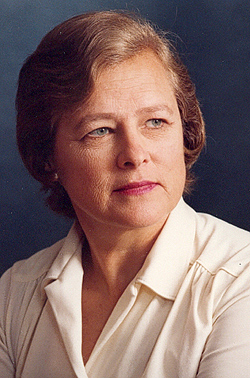July 21, 2009 - By Stephanie Pappas
STANFORD, Calif. — Margaret Billingham, MD, a founder of the field of cardiac transplantation pathology who developed the “Billingham’s criteria” that doctors still use to grade heart transplant rejection, died of kidney cancer on July 14. She was 78.
Billingham, director of cardiac pathology emeritus and professor of pathology emeritus at the Stanford University Medical Center, left behind a curriculum vitae spanning 50 years and more than 50 pages. Best known for her work in the field of pathology of cardiac transplant rejection, she also made major contributions to research into the toxicity of the chemotherapy drug adriamycin and the development of heart biopsy techniques. Colleagues described her as a reflective and generous mentor, whose support was especially beneficial to younger female faculty members during a time when few women had achieved such a senior position.
“She was by far the most prominent and well-known cardiac pathologist in the world,” said Robert Robbins, MD, director of the Stanford Cardiovascular Institute and professor of cardiothoracic surgery. “Her contributions were the key to advancing the care and survival of heart transplant patients.”
Billingham was born on September 20, 1930 in Tanga, Tanzania, where her father worked for the British government. She graduated with her medical degree from the Royal Free Hospital School of Medicine in London in 1954.
In 1966, she came to Stanford as a postdoctoral fellow in cardiology, staying on as a pathology resident and postdoctoral fellow in surgical pathology. There, she impressed colleagues with her efficiency and interest in cardiac pathology. It was an era of excitement in that field—Norman Shumway, MD, PhD, would perform the first successful heart transplant in the United States at Stanford in 1968—and Billingham became interested in the pathology of cardiac transplant rejection. Along with visiting scientist Philip Caves, MD, she developed methods of diagnosing transplant rejection from tiny snippets of heart tissue. She would carry on that work through her appointment as an assistant professor of cardiac pathology in 1975, associate professor of pathology in 1981 and professor of pathology in 1988.
“She developed the grading system for the diagnosis and reporting of acute rejection; she also described the pathology of chronic rejection in heart transplants, and she taught legions of pathologists how to diagnose rejection,” said Gerald Berry, MD, professor of pathology. “She basically developed the whole area of pathology of cardiac transplantation.”
One of Billingham’s contributions, a standardized scale for interpreting the biopsy results from transplanted heart tissue, still bears her name: The Billingham Scheme, or Billingham’s criteria. Not only did Billingham create the grading system, said Sharon Hunt, MD, professor of cardiovascular medicine, she also successfully worked to get a similar method accepted as standard by the international community.
“That was just an amazing contribution to the field, so that we could organize and unify our approach to diagnosis and treatment,” said Hunt.
In addition to her academic contributions, Billingham mentored her Stanford colleagues as well as pathologists from around the world who came to study with her.
“She was a very gracious, warm and kind person,” Berry said. “She would host lavish dinner parties at her home and always went out of her way to include everybody.”
As a woman who started her career at a time when it was rare to find female medical faculty at academic medical centers, Billingham was particularly dedicated to advocating for female faculty in her department. In 1991, she was appointed director of women in medicine and medical sciences at the School of Medicine. Beyond her formal role, she provided a role model for the balance of career and family, and her calm demeanor made her a sought-after advisor.
“She had such a good appreciation of the trials and tribulations of women in medicine,” Hunt said. “If I had an issue or a problem I wanted to talk out, she would be the one I would seek out. She put you at ease.”
Billingham was a Fellow of the Royal College of Pathology. She became the first female president of the International Society for Heart and Lung Transplantation in 1990, and was elected president of the Society for Cardiovascular Pathology in 1993. Among her many honors was the Award of Distinguished Pathologist of the Year for 2001 from the U.S. and Canadian Academy of Pathology.
In 1994, Billingham became an emeritus professor, and she and her husband retired to Penn Valley in the foothills of the Sierra Mountains in Northern California. There, she enjoyed gardening, fishing, traveling and exploring California with her family.
“She was a remarkable woman filled with grace and humility, who left this world a better place and touched the lives of so many,” wrote her husband John Billingham, MD, former chief of the life sciences division at NASA Ames Research Center. “It was a life full of strong family ties, joy and happiness, excitement and achievement, and a distinguished professional career in the world of medicine.”
In addition to her husband, Margaret Billingham is survived by her sister, ShirleyAnn; sons Bob and Graham of Auburn; daughters-in-law Christine and Jeanine; and grandchildren Briana, Caitlin, Cameron and Megan. Donations in her memory can be made to Habitat for Humanity. Individuals wishing to share their thoughts and memories of Billingham may make comments on an online guestbook in her honor at http://med.stanford.edu/ism/2009/july/billingham/comments-guestbook.html.
About Stanford Medicine
Stanford Medicine is an integrated academic health system comprising the Stanford School of Medicine and adult and pediatric health care delivery systems. Together, they harness the full potential of biomedicine through collaborative research, education and clinical care for patients. For more information, please visit med.stanford.edu.
